PMQ (Hong Kong)
PMQ (former Police Married Quarters), is a historic site containing a grade III listed building, the old Hollywood Road Police Married Quarters, now used as a mixed-use venue for arts and design, in Hong Kong, between Aberdeen Street, Staunton Street, Hollywood Road, and Shing Wong Street.[1]
| PMQ | |
|---|---|
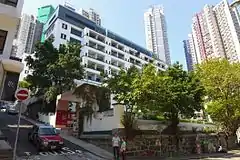 PMQ in October 2015 | |
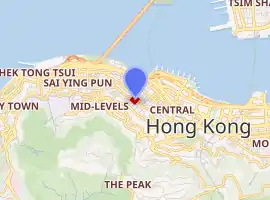
| |
| Former names | Police Married Quarters |
| General information | |
| Status | Grade 3 Historic Building |
| Address | 35 Aberdeen Street |
| Town or city | Central |
| Country | Hong Kong |
| Completed | 1951 |
| Renovated | 2014 |
| Renovation cost | HK$577 million |
| Technical details | |
| Floor area | Approx 6,013 sqm. |
| Renovating team | |
| Architect | Architectural Services Department |
| Awards and prizes | HKIE Structural Excellence Grand Award, QBA Quality Excellence Award, HKIA Special Architectural Award, RICS Hong Kong Award, HKILA Merit Design Award |
| Website | |
| pmq | |
| PMQ | |||||||||
|---|---|---|---|---|---|---|---|---|---|
| Traditional Chinese | 元創方 | ||||||||
| |||||||||
| Police Married Quarters | |||||||||
| Traditional Chinese | 已婚警察宿舍 | ||||||||
| |||||||||

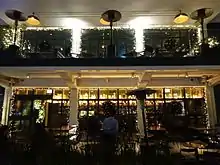
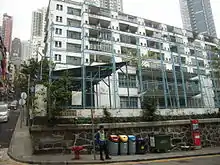
The site occupies what was originally the grounds of Queen's College, which built a school on the site in 1889. After wartime damage, the site was repurposed as quarters for married junior policemen.[2] The compound is listed as a Grade III historic building since 2010.[3] In 2014, after nearly 15 years of disuse, the building was renamed PMQ and opened to the public. The building's residential units were turned into studios, shops and offices for creative enterprises and exhibition spaces.
History
The Central Government School was built on Gough Street in 1862 and it was the first government primary and secondary school in Hong Kong, which provided western education to the public.[4] In 1889, due to the increasing number of students, the school had to relocate to a new campus on Hollywood Road. Later on the school was renamed 'Victoria College', then Queen’s College in 1894. At that time, the school was one of the largest and most expensive buildings in Hong Kong. Many local leaders and talent have been nurtured at this school, including the Father of Modern China, Dr Sun Yat-sen and business tycoons such as Sir Robert Ho Tung. They were all elites at the time and contributed a lot to Hong Kong and China’s development. However, during the Japanese Occupation in 1941, the building was destroyed. In 1948, the remaining building was demolished. In 1951, in order to increase the police recruitment in response to the influx of Chinese immigrants after the Chinese Civil War, PMQ provided 140 single room units and 28 double room units for the rank and file officers serving at the nearby Central Police Station. Former Hong Kong Chief Executives C.Y. Leung and Donald Tsang have both lived there. In 2000, the building was emptied.[5] In 2009, the 'Conserving Central' project mentioned in the Policy Address that eight heritage sites in Central including PMQ should be renovated. Finally in April 2014 PMQ started to operate as a creative hub.[6]
Features
The original PMQ site area was around 6,000 square meters.[7] However, after the revitalization, the total floor areas became 18,000 square meters. Because the location is near the galleries and boutiques in Sheung Wan, Central and Hollywood Road, it is successful in attracting around 100 design galleries, shops, bookstores and office units to start their business there. Moreover, there are fifteen ‘pop- up’ units for design exhibitions and outlets. A 1,000 square meter central courtyard for events and exhibitions, the Panda-mania was held in 2014, 1,600 paper pandas were placed in the central courtyard for exhibition about the conservation of the endangered animal. To promote the historic background of PMQ, a tunnel allows visitors to go through the foundation of the former Victoria College.
Conservation policy
Between 2005 and 2007, the Antiquities and Monuments Office (AMO)[1] conducted some investigation into the remnant at PMQ. They found the remains of the Central School, including the granite shafts and plinths of the boundary walls and the retaining walls, the quoin stones at the corners of the site and the steps. The AMO rated PMQ as Grade III Historic Building in 2010. In 2008, the government underwent the public engagement exercise between February and May to collect opinions for the use of PMQ. In response to the public’s views, the government suggested revitalizing PMQ’s uniqueness to promote creative industries, to conserve heritage and to provide public space. The revitalization of PMQ was based on six principles:
- Preserve the historical relics;
- Emphasize the cultural and historical value and the original ambience;
- Give it a new lease of life by gathering the creative industries to make it become a landmark for local residents and visitors;
- Contribute to the comprehensive planning along Hollywood Road and surrounding area on the proposed ‘spot, line and area’ heritage conservation methods;
- Respond to the concerns of community for the development density and the building height;
- Fulfill the expectations of the community for having more public space.
Architecture
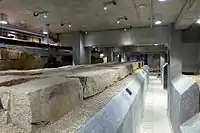
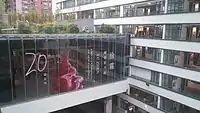
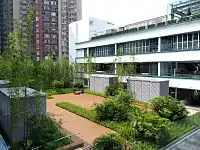
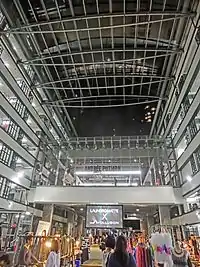
The PMQ consists of two blocks of the former Hollywood Road Police Married Quarters, named Stauton and Hollywood, and the former Central Junior Police Call Clubhouse. The two seven-storey buildings are now turned into shops and galleries. The former clubhouse is revitalized into a restaurant with its original designs intact. One more block named 'CUBE', is added as the linkage between the two blocks. A special feature of the 'CUBE' is its rooftop garden 'PLATEAU' on the fourth floor.
Modern architectural designs are applied on the PMQ, one remarkable feature is the glass ceiling which is anti-UV. It protects people from being hurt by the UV rays while allowing natural light inside the building.
As a grade III historic building in Hong Kong, much heritage can be found in PMQ. For example, the main entrance of the quarters. The granite steps and rubble retaining wall, entrance at Staunton Street were from the Central school. Guests can take the Underground Interpretation Area Walk-in Tour or the PMQ Heritage Interpretation Guided Tour, to get more information of heritages in PMQ and to know more about the historical and architectural values or the remains. Both tours are free of charge.
 Granite steps and rubble retaining wall
Granite steps and rubble retaining wall Granite steps of the Central School
Granite steps of the Central School Entrance of the former Central School
Entrance of the former Central School Shop display in PMQ
Shop display in PMQ Shops in PMQ
Shops in PMQ
Special events
PMQ organize many programs and events every month. All of them are related to arts like galleries, exhibitions, music performances and design talks. They are all free of charge, open to everyone. Workshops are held to encourage visitors to have a hand-on experiences of arts. PMQ invite artists from all over the world to display their work.
One of the special events is night market. Night market is held once a month. It can be divided into three parts: live band show, product design and food stall. Many local designers take part in it. Booths are set up at the ground floor to promote their design products. Live band show is held, you can see the performances of children and some local singers. There are also booths selling some instant made food which welcome guests around the world.
Some international exhibitions are held in PMQ also. Previously, there were an international exhibition called “1600 Pandas” organized by WWF. In order to raise people’s awareness of protecting the environment, the exhibition displayed 1600 paper-made pandas. It shows that PMQ is becoming one of the major art centers in Hong Kong.
 Night Market
Night Market Live Band
Live Band 1600 pandas
1600 pandas
References
| Wikimedia Commons has media related to PMQ. |
- "Former Police Married Quarters on Hollywood Road". Heritage.gov.hk. Retrieved 18 March 2020.
- "History of PMQ." Retrieved 2017-06-21
- List of new items and new categories with assessment results Archived 15 November 2017 at the Wayback Machine (as at 4 March 2014)
- Sweeting, A.E. (1991). Education in Hong Kong, Pre-1841 to 1941: Fact and Opinion. Hong Kong University Press. pp. 150 & 214. ISBN 978-962-209-258-7.
- Antiquities and Monuments Office: "Former Hollywood Road Police Married Quarters. 2007 Site Investigation Report" Archived 15 October 2012 at the Wayback Machine
- "LCQ12: Management and operation of PMQ." Press Releases. Government. Retrieved 2017-06-20.
- "PMQ: The new creative hub". Time Out Hong Kong.
External links
| Wikimedia Commons has media related to Former Hollywood Road Police Married Quarters. |
- Consultancy for Heritage Impact Assessment for Transformation of the Former Police Married Quarters Site on Hollywood Road into a Creative Industries Landmark. Volume 1 - Built Heritage Impact Assessment. Architectural Services Department. March 2011
- Historic Building Appraisal. See Item #N14
- PMQ website